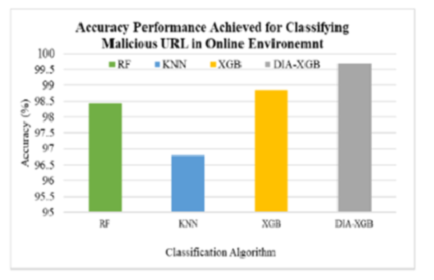


Indian Journal of Science and Technology
DOI: 10.17485/IJST/v15i11.1813
Year: 2022, Volume: 15, Issue: 11, Pages: 481-488
Original Article
Sagargouda S Patil1*, H A Dinesha2*
1Assistant Professor, Computer Science, Jain College of Engineering and Research, Belagavi, Karnataka, India
2Professor& HOD, Computer Science, Nagarjuna College of Engineering and Technology, Bangalore, Karnataka, India
*Corresponding Author
Email: [email protected]
[email protected]
Received Date:29 September 2021, Accepted Date:10 February 2022, Published Date:22 March 2022
Objectives: To present a model which can detect malicious attacks using the URL of the Social Communication Platform using the data imbalance machine learning algorithm. The main objective is to detect the attack and prevent it from happening. Methods: This study presents an efficient feature extraction and selection method addressing feature imbalance problems; and also presents an improved concept drift and machine learning-based classification. This paper extracts the URL of the undesired tweets, identifies them, and filters them for classification. Findings: The experiments have been conducted using the drifted twitter spam dataset. Our model DIA-XGBoost extracts the URL of the undesired tweets, identifies them, and filters them for classification. Further, the attack pattern varies with respect to time. Furthermore, the results show that our DIA-XGBoost attains higher accuracy performance by 1.254%, URL recall performance by 0.14%, and increased Fmeasure performance by 10% when compared with the existing ML techniques (Random Forest, K-Nearest Neighbour, XGBoost). Thus, the existing ML-based classification model achieves poor classification accuracy whereas our model solves this issue. Novelty: Various Machine Learning (ML) techniques have been applied for the classification of URL redirection attacks. However, the spam data generally exhibit feature imbalance. Further, the attack pattern varies with respect to time. Thus, the existing ML-based classification model achieves poor classification accuracy. Hence, our model solves the issue using the DIA-XGBoost algorithm, detects and prevents URL malicious attacks.
Keywords: Data Imbalance; Feature Extraction; Concept Drift; URL; Machine Learning; URL Redirection Attack
© 2022 Patil & Dinesha. This is an open-access article distributed under the terms of the Creative Commons Attribution License, which permits unrestricted use, distribution, and reproduction in any medium, provided the original author and source are credited.
Published By Indian Society for Education and Environment (iSee)
Subscribe now for latest articles and news.